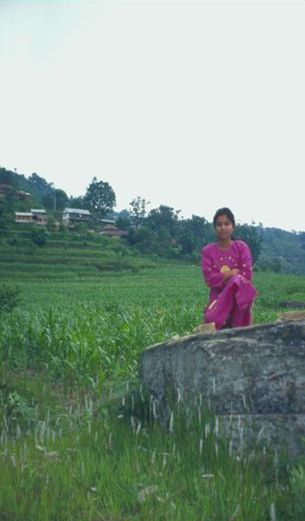

Introduction
Chapter 1
Chapter 2
Chapter 3
Chapter 4
Chapter 5
Chapter 6
Conclusion
References
PDF Version - Full Report

Anne E. Desjardins1 and Susan A. McCarthy2
1 National Center for Agricultural Utilization Research, Agricultural Research Service, USDA, Peoria, IL, 61604, and 2National Agricultural Library, USDA, Beltsville, MD, 20705.Introduction
Every spring in the Himalayan mountains of Nepal, farmers plow their terraced fields and plant maize (Zea mays), an American crop plant. Nepalese farmers plant yellow-seeded maize, orange, red, white, and multi-colored maize. Women grind the grain for a thick porridge to be eaten with lentils and vegetable curries at the two main meals of the day. Field workers carry popcorn and pots of fermented maize beer for their midday lunch. Farmers feed green maize stalks to their water buffaloes and goats when other fodder becomes scarce during the spring dry season. Dried maize stalks and husks are used for weaving fencing and mats. And during the ceremonies of the autumn harvest festival of Dasain, villagers wear tikas of rice and yogurt on their foreheads and pale yellow seedlings of maize in their hair.

|

|

|

|

|

|

|

|

|

|
In March 1972, I watched farmers plowing and planting maize in Lamjung district in Nepal, where I was a Peace Corps science teacher. In my two-room stone house, I sat by the wood fire and ate maize porridge with lentils and mustard greens. As I ate my maize, I wondered how an American crop plant had become a staple food in a remote region of the Himalayas. My neighbors were convinced that their maize, or makai, was "local", and only one among the many crop plants, such as rice, millet, and buckwheat, that actually are indigenous to the Himalayas. They believed that maize and other American crop plants like the chili peppers and tomatoes they used in their curries had been with them from ancestral times. After I left Nepal in 1973, I pursued a career in scientific research on fungal diseases of maize and wheat in the United States, but I also returned to Nepal on four more occasions. In 1993 I began field work on fungal diseases of maize in Nepal in collaboration with scientists at the Nepal Agricultural Research Council. But 30 years after I first saw maize being planted in Lamjung, I still had no satisfactory answer to my questions about the introduction of maize to Nepal. To answer these questions, I began a collaboration with Susan McCarthy, a plant physiologist and agricultural historian, to research the history of maize in Asia. In this article we present our first discoveries of early journeys of maize to Asia. We hope that our study will serve as a foundation for future research.
This article begins with the discovery of maize in Mesoamerica by Columbus in 1492. Subsequent chapters follow the journeys of maize eastward, as milho, makka, and yu mai, to Europe, Africa, Asia, and Australia. Each chapter section begins with a general description of the types of evidence we have discovered for each geographical region, then continues with specific references to maize in general chronological order. We have focused as much as possible on the earliest records from the 16th to 18th centuries, and we have included 19th century material only when earlier data are scarce. Because many of the older source texts may be difficult for the general reader to obtain and because they often contain no subject indexes, we have provided numerous direct quotations and page numbers for specific references. We have not edited quotations to correct or modernize spelling, but we have simplified some quotations by omitting capitals except on proper nouns. Within quotations, brackets indicate original material and parentheses indicate material we have added. Because neither of us has the linguistic skills to read Portuguese, Spanish, African, or Asian languages, we have relied on English and French translations of texts in those languages. Otherwise, we have made a serious effort to use direct eye-witness accounts and other primary sources.

|

|
We are grateful for the assistance of many librarians, especially Joyce Blumenshine and Michelle Yoder at the National Center for Agricultural Utilization Research, Miguel Garcia at the Royal Botanic Gardens Sydney, Louise Anemaat at the State Library of New South Wales and Toni Swann at the National Agricultural Library. We thank Mercedes Panizzi for translation of Portuguese material and Deepak Bhatnagar for translation of Hindi material. Field work in Nepal was conducted with support from the USDA and the United States Fulbright Foundation, with the collaboration of Gyanu Manandhar, Hira Manandhar, and other scientists at the Nepal Agricultural Research Council, and with the cooperation of the people of Lamjung district.